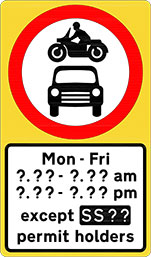About School Streets
A School Street is where one or more roads (or a part of a road) near a school entrance temporarily close to motor traffic at the beginning and end of the school day. A School Street creates an area with reduced vehicular movements and a quieter and calmer experience for school children and other pedestrians and cyclists.
Signs inform drivers of the restrictions before the entrance to the School Street.
Why we want to create School Streets
School Streets are part of our strategy to improve road safety, traffic congestion, and air quality outside the school gates where the highest concentration of vulnerable road users congregate.
The drop-off and pick-up rush at opening and closing times can produce an unsafe environment for pedestrians and motorists alike. Parked cars, running children, and manoeuvring vehicles pose hazards even to the best of drivers. Residents are also inconvenienced by drivers from outside the neighbourhood using local streets as a ‘cut through’ to bypass main roads. School Streets transform residential roads into quieter, calmer spaces.
School Streets are designed to:
- Improve road safety
- Reduce traffic outside schools
- Improve air quality, with fewer engines idling
- Reduce inconsiderate parking and dangerous manoeuvres
- Encourage more walking, cycling, and kick-scooting to school
- Support the mental and physical wellbeing of all children
- Create a safer, calmer, more pleasant street
We have been working with schools in the borough to promote active travel for a number of years through the TfL school travel plan portal, however many schools and parents are still concerned by road safety and air pollution around schools.
We receive many requests for general traffic management and safety improvements that are demonstrated to not be justified, given finite resources, in terms of accidents, speeds and traffic flows.
However, a more moderate approach is taken near schools recognising the particular concerns there are towards children's safety, active travel and exposure to pollution. It is hoped that some of these concerns will be addressed by reducing the number of vehicles at school start and finish times.
New schemes are being proposed under an experimental traffic order to be able to monitor any impacts before considering making the schemes permanent.
Restrictions
Vehicles will not be able to enter the streets during the hours of operation unless they are exempt. See our frequently asked questions section for further details of exemptions and how to register an exemption online for CCTV ANPR camera enforced School Streets.
Signs, like the generic example alongside, will inform drivers of the restrictions before the entrance to the School Street. At some closures, advance warning signs will be installed, where needed, as will camera signs, where appropriate.
School Streets exemptions are separate from Controlled Parking Zone permits and other camera enforced traffic reduction schemes, and one does not cover the other. School Streets are access restrictions and CPZs are parking restrictions.
Having a permit for the relevant CPZ/other traffic reduction schemes or a valid blue badge will not permit you to enter the School Street during the hours of operation. You will face the risk of incurring a penalty charge notice (PCN).
While a CPZ permit or blue badge will be required to park, it does not qualify you to enter the School Streets scheme during the operational times and an exemption application must be made.
Residents and businesses who live and work within camera enforced School Street restricted areas will be able to apply for free exemption, as well as Blue Badge holders needing to access these properties. This also includes eligible visitors to the area.
Vehicles already parked within a School Street can exit without a penalty.
When School Streets are operational
School Streets operate Monday to Friday term time only, but signs will not be closed during school holidays and half term breaks. It is not a statutory requirement to close them.
Refer to school term dates for more general information, or School Street locations for specific school enforcement and holiday dates. Please also check the locations table for occasions where a school day has an early finish at the end of term.
Enforcement
There are three main methods of School Street enforcement used in Richmond.
Physical barriers
Some School Streets are enforced by physical barriers with volunteers preventing access. This method of enforcement tends to be used at the start of a scheme until it settles. This is not expected to be a long-term management strategy and only works when a school can identify staff or parents, residents or community volunteers to support.
Automatic Number Plate Recognition (ANPR)
ANPR cameras work best for streets with higher traffic volumes often used by drivers as cut throughs. ANPR cameras are not appropriate for all locations and require exempt vehicles to be registered on an exemption list.
Signs
School Street signs are the ideal method of enforcement once a School Street scheme is settled and in place. Signs work best for low volumes of traffic or roads that are mainly used by residents and the school community, who understand and support the restrictions.
We are also rolling out an enhancement programme for School Streets which was recently trialled at St John the Baptist. This includes visual features to make School Streets more visible, recognisable and uniform.
Refer to School Street locations for details of each schemes enforcement method.
Vehicles already parked within a School Street can exit without a penalty.
School Streets can only be enforced during the time shown on the sign.
Exemptions
A school street exemption is only required for school streets enforced by ANPR.
Find out how to apply for a School Street exemption.
Locations
Refer to School Streets locations for details of each School Street. View a borough map of all the locations.
For more information email schoolstreets@richmond.gov.uk.
Frequently asked questions

 Stay up to date! Make sure you subscribe to our email updates.
Stay up to date! Make sure you subscribe to our email updates.
